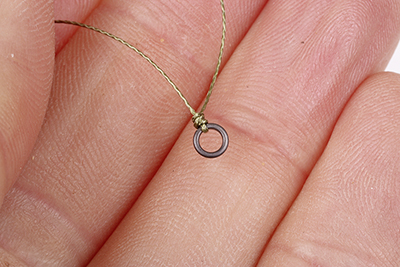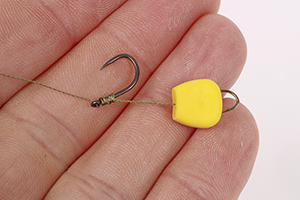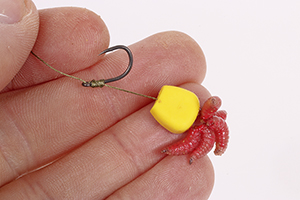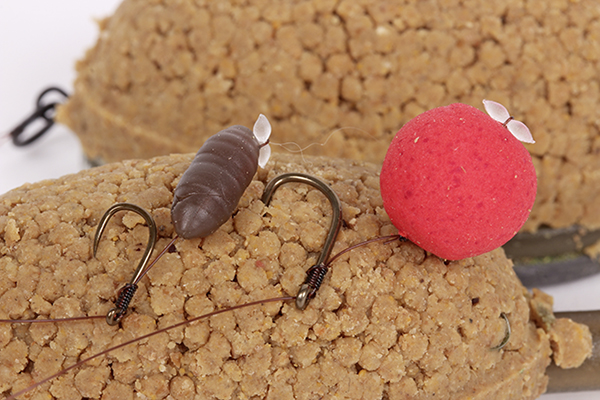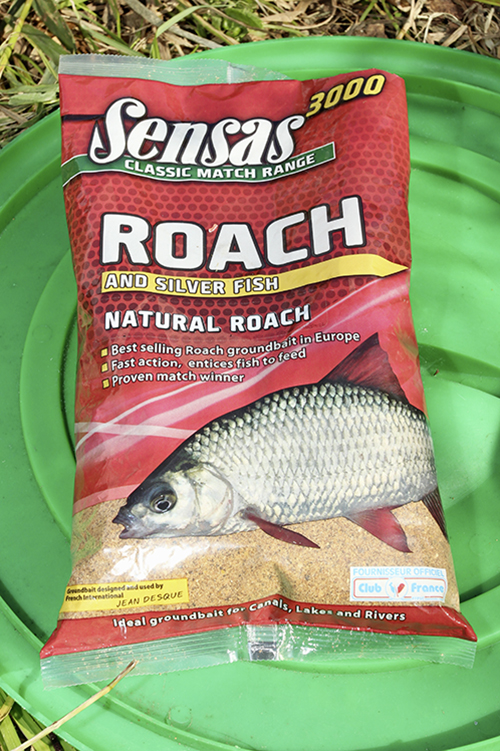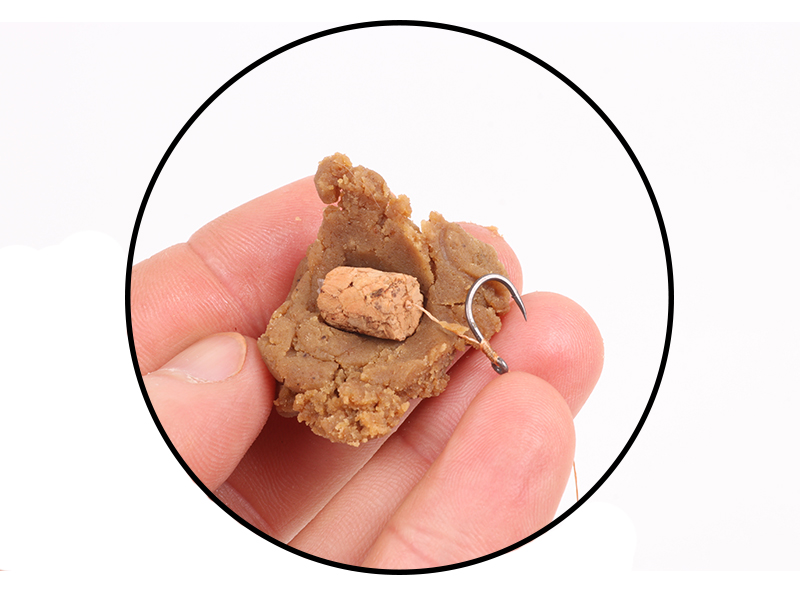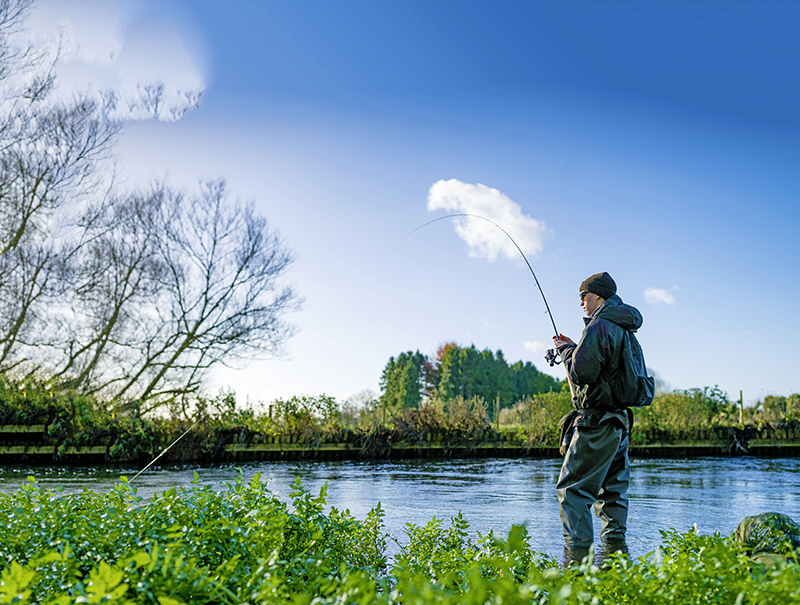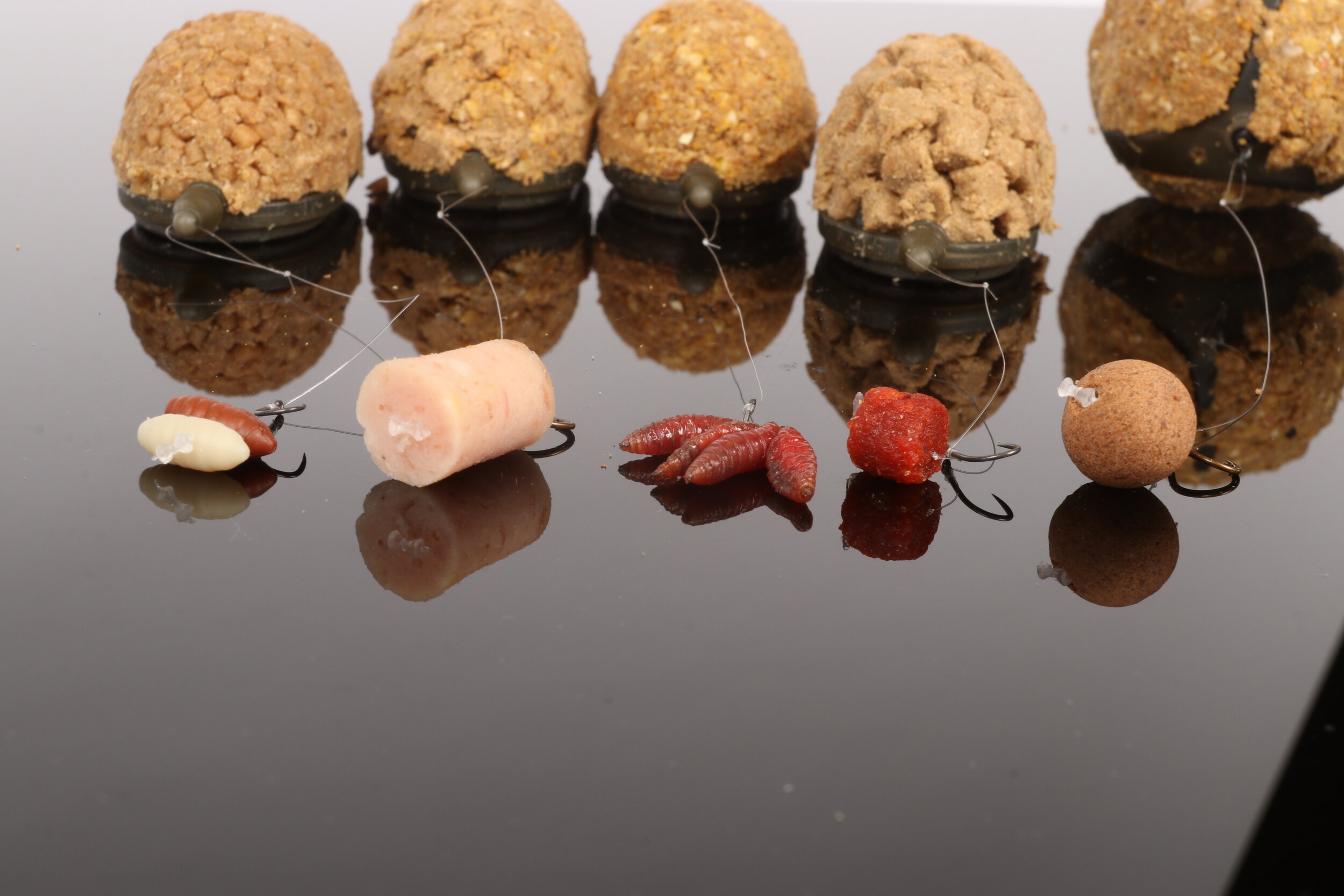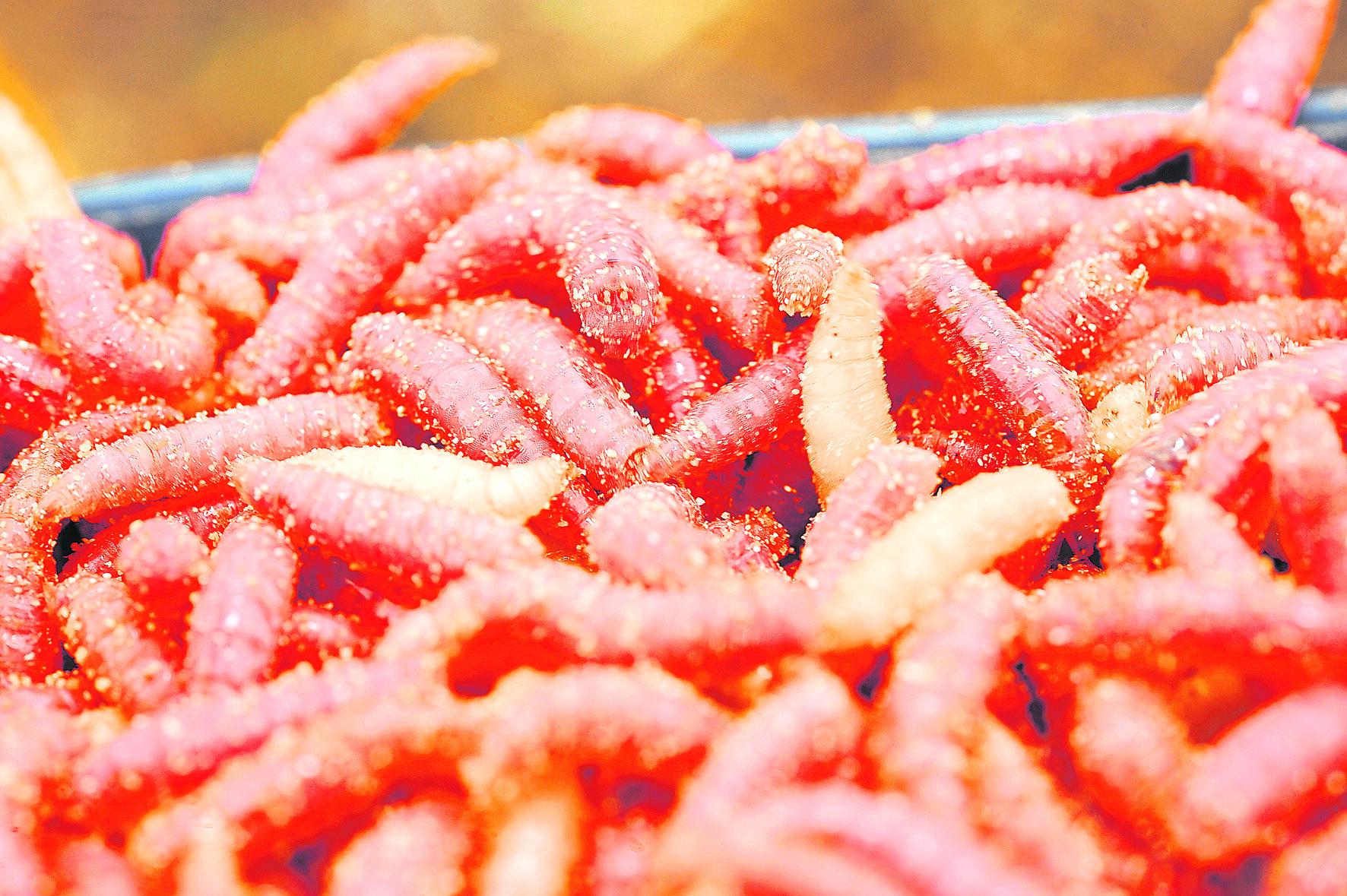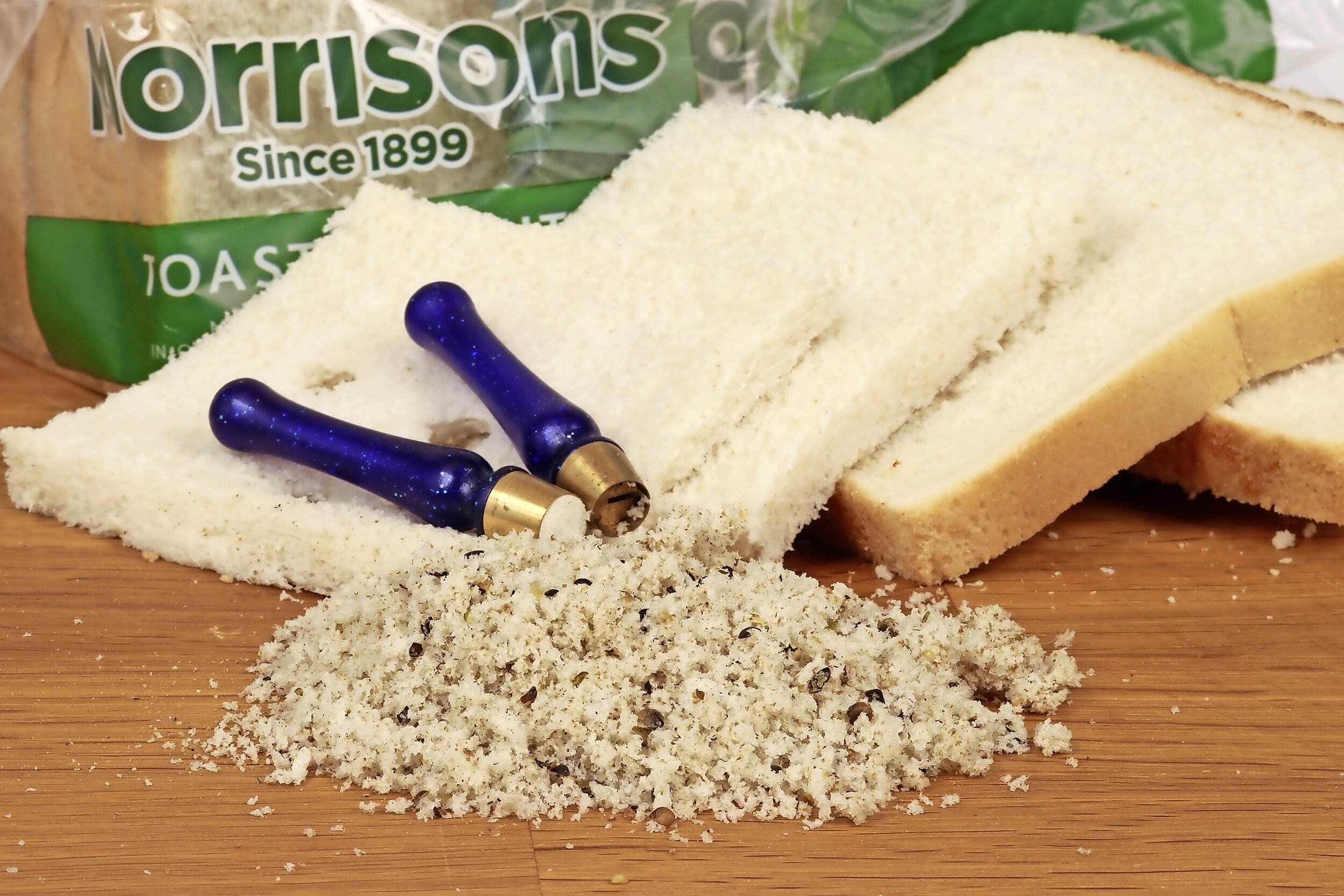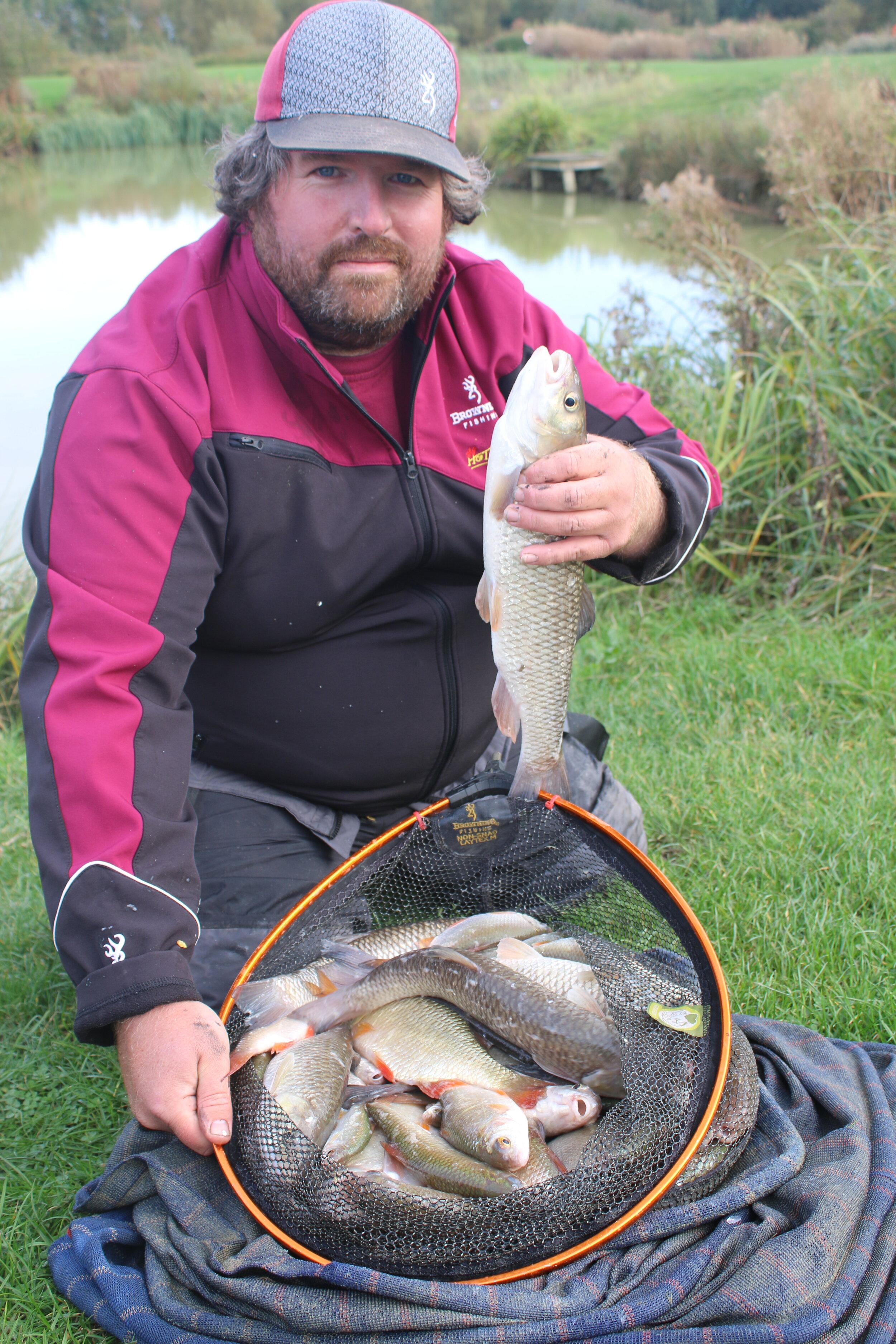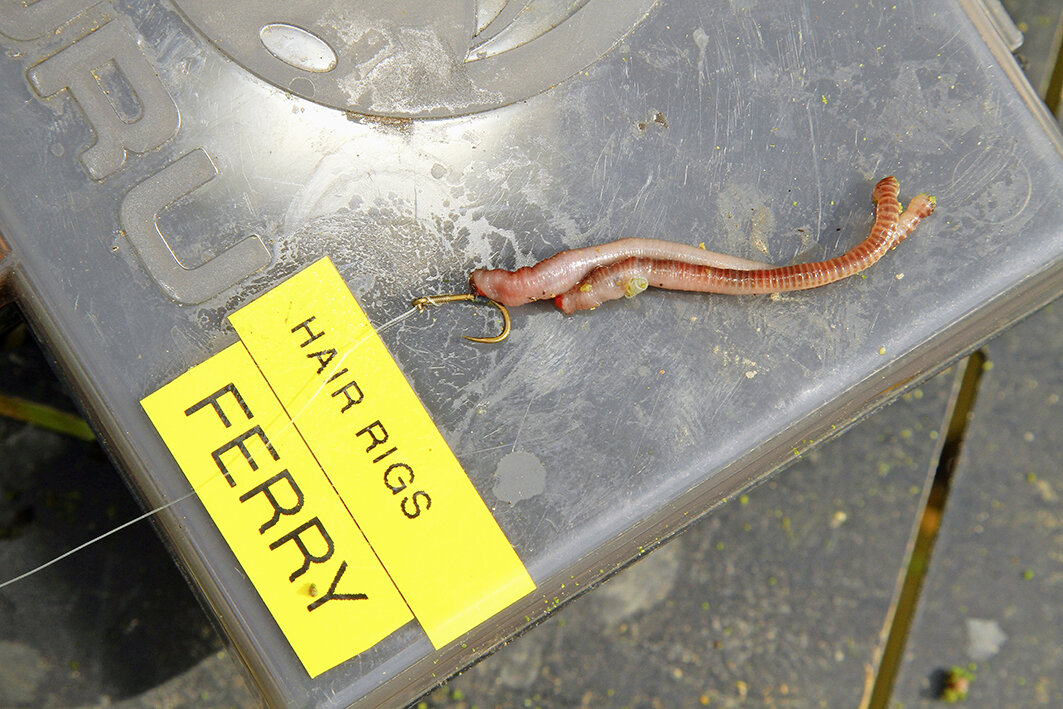Dean Macey's Carp fishing tips
Former champion decathlete Dean Macey likes nothing more than to get down to his local lake for some early-spring carping. So here are some clever carp fishing tips to help him catch...
Small parcels
“My springtime mindset is all about small parcels of loosefeed, regularly fed all day, to keep the swim active.
“If you try to force the issue by feeding heavily at the start you might get one or two early fish but they don’t tend to settle at this time of year. Better to fish for one bite at a time, rather than try to empty the place from the off.
“If the swim is lifeless, I’ll add a bit more feed. Just a couple of catapults or small Spombs over the top will add fresh smell, make a noise and ring the dinner bell.”.
Zigs will catch!
“I never leave home without some gear for zig-rigging to fish from the bottom up. The fish are looking to feed after winter in preparation for spawning, so they tend to move quickly around the water, looking for easy meals.
“I look for ‘shows’ first – ideally fish crashing out rather than just lifting their heads and shoulders through the surface. This means they are moving around the water.
“Start at a two-thirds depth and offer your hookbait up or down to find the level at which fish are feeding.”
Use bait wisely
“Even if I’m zig-rigging, I’ll still put down a bed of loosefeed so I can fish a simple carp rig on the bottom later on.
“It’s easy to combine feed for zigging and bottom fishing. I use a Spod mix including hemp, 10mm Mainline Cell or New Grange boilies and enough liquidised bread and Mainline Cloud 9, mixed 50/50, until a thick porridge is formed.
“The Cloud 9 and liquidised bread form a cloud in the upper layers, great for zig fishing, while the hemp and boilies sink quickly, allowing me to fish effectively on the bottom with a second rod. The Cloud eventually sinks and forms a light covering on the deck.”
Feed & fish tight
“At this time of year, carp
tend to feed only in short spells, so make sure you are fishing effectively over your feed. I’ll use a Spomb to loosefeed, then place one rig right in the centre of the feed, and one on the edge.
“The bigger, more wary fish tend to hang off the bait which is why they are rarely caught.
“Just like a match angler when fishing the feeder, I’ll line up my swim with a permanent far-bank marker before tying line markers on to my mainline. These allow me to clip up so I’m able to hit the same spot, every cast.”
Simple rigs
“If the lake has a silty bed, which many do, my bottom rig will consist of 15ins of coated braid to aid presentation. I’ll add a small PVA bag of pellets which slows the rig’s descent and helps it to settle gently on the soft bottom.
“I also fish a size 6 hook, tied KD style where the hair comes off the hook just under the eye.
“With a heavy hook and a light hookbait, the hook point is always looking to drop down and find a latching point – as proved by the five fish I’ve caught today. All were nailed in the bottom lip, an inch down the throat.”
Top tips for creating a great groundbait mix
Want to know how to create the perfect mix of groundbait for your fishing? Then check out these great tips from Jamie Hughes about how to put together a groundbait mix that will be irresistible to skimmers and commercial carp.
1) There will be lots of groundbait on the shelves of your local tackle shop, and it’s important to pick the right product. A pellet-based product such as Bag ‘em Matchbaits XP is best for F1s, a dark blend like Super Skimmer Dark which colours the water should be used for bream and skimmers, while something with plenty of fishmeal such as Commercial Carp is ideal for mirrors and commons.
2) Pour your groundbait into a large bucket. This will give you plenty of space and enable you to thoroughly distribute the water so that every crumb of groundbait is evenly wetted.
3) For every kilo of dry groundbait, tip in just under two pints of water, and don’t be alarmed if it looks like a watery mush. Thoroughly mix the water in with your hands and leave the mix to stand for around 15 minutes.
4) By now it will have absorbed all the water but still contain lumps that could feed the fish, which you don’t want. Take another bucket and lay a riddle on top. Push handfuls of groundbait through the small holes to remove the lumps.
5) Riddled groundbait will be light and fluffy, with plenty of attraction, and without lumps it will have a fairly low feed content. It is now ready for use, but why not add extra attraction by thoroughly mixing in a little liquid additive?
6) A perfectly-mixed groundbait will easily form a ball when squeezed, but will crumble when rubbed between your hands.
How to make bread bombs
How do you get winter carp actively looking for food – which makes them more likely to get caught – without filling them up?
A partial answer is to use a bait with quite a lot of volume but little food value... liquidised bread.
Put through a blender, the flaky crumb of a loaf becomes fine, fluffy particles. These expand quickly to produce a slow-sinking feed that is perfect for incorporating into PVA sticks, drawing attention to the hookbait.
Because it is so easily washed away there’s no point in piling in liquidised bread. Much better is a small PVA parcel called a ‘bread bomb’. The wash from carp moving around the swim will lift a cloud of fine flavoursome particles, drawing attention to the presence of some grub.
1) Remove the crusts from a few slices of medium-cut white bread.
2) Liquidise three slices at a time, making sure that you get rid of all the lumps.
3) Add half-a-teaspoonful of powdered dye of your choice to the bread crumb.
4) Make up a 50-50 mix of stick mix and liquidised bread.
5) Add a level teaspoonful of white sugar to the dyed stick mix and bread crumb.
6) Add some of the mix to a narrow fast-melt PVA stick.
7) The finished sticks should be about the size of a 50p piece.
How to catch carp on maggots
In the winter months, catching big carp can be quite difficult as they seem to switch off from the usual feed of boilies and pellets and instead turn their heads towards more natural baits such as Maggots. Which is why knowing how to hook your maggots correctly and efficiently is crucial when it comes to catching more carp. Below are two ways of rigging your maggots the first way is via threading this when you thread maggots onto a hair rig creating a big ball of natural bait for the carp to feed on. The second way is to add corn to this mix as this gives off some colour that will help catch the eye of any passing carp.
We asked Nash backed Paul Garner to show us how to hook up these two rigs correctly when fishing for big carp.
Rigging maggots
Although maggots will catch the largest carp around, using such a small bait on strong tackle can be problematic. In open water you can simply scale down your rigs and use a bunch of maggots straight on the hook. I like to use a size 10 or even a 12 hook, as long it is a forged pattern that is quite thick in the wire.
Half-a-dozen grubs on a hook of this size is about right. I tend to hook the grubs through the head end, rather than the conventional way, as used this way they are less likely to mask the hook.
If you want to hair-rig maggots, there are several ways. A size 8 or 10 hook gives a secure hookhold.
Threaded: I use a fine sewing needle to load a bunch of maggots on to a piece of strong sewing thread and then tie this to a small rig ring attached to the hair.
This neat and simple method allows me to make the maggot baits as large or as small as I want with minimal fuss.
Maggot clip: Another simple alternative is to use a maggot clip loaded with grubs. Once again this is tied to the hair and then loaded with maggots. You can buy clips in several sizes to match the number of maggots you want to use as a hookbait. I tend to add a sliver of ring foam to the maggot clip to counterbalance its weight.
Corn and maggot: For a substantial hookbait, combine maggots with a grain of plastic corn. This rig incorporates a size 12 round bend hook tied to the end of the hair with the piece of plastic corn pulled over the point.
Three or four maggots are mounted on the small hook, the point of which is then pulled securely into the plastic corn.
The corn provides a visual slow-sinking hookbait, with the added benefit of the bunch of wriggling grubs. Fish this with a PVA stick.
HOW TO THREAD YOUR MAGGOTS
1) Thread six maggots on to a sewing needle, thick end first.
2) Slide the maggots off the needle and on to a length of sewing cotton.
3) Tie a small metal ring to the end of your hooklength to form the hair.
4) Slide on tubing and then tie on the hook itself, using a knotless knot.
5) Tie the threaded bunch of maggots on to the small metal ring.
6) The finished rig is very neat and all ready to catch you a winter carp.
CORN AND MAGGOT
1) Tie a size 12 hook to the hooklength and thread on a grain of plastic corn.
2) Tie on your main, unbaited hook using a standard knotless knot.
3) Hook five maggots on to the small size 12 hook with the corn above.
4) Attach the stick by hooking it through the dissolving foam.
10 of the best roach fishing tips
There are few finer sights in angling than a specimen roach, or a net of silvers caught on a freezing cold day. To help you have a better chance of catching your best-ever roach we've asked Paul Garner about his top roach fishing bait tips.
I reckon roach are making a very welcome comeback, although often they go unnoticed until caught by accident by carp, bream and barbel anglers.
These accidental catches, though, hint at the fact that rather than being the delicate feeders that we once believed, roach are in fact catchable on a much wider range of baits and tactics.
Choosing the right tactic is key, and it’s surprising how roach in various venues can behave very differently, especially to baits.
Follow my tips and you won’t go far wrong, wherever you may choose to fish.
1) Fresh is best
Roach are one species where I think it is essential to keep your maggots in top condition.
The fresher and softer the bait, the more roach you will catch – it’s as simple as that.
Ask your local tackle shop when they get their maggot deliveries and try to buy yours soon after they arrive.
I then riddle off any sawdust and replace it with maize flour, which softens their skins and gives you the best bait possible.
2) Big baits for big fish
On venues that contain a lot of roach, including some big ones, the easiest way to sort out the specimens is to use a larger bait.
A 2lb roach can easily handle a lobworm, double sweetcorn or a 10mm boilie. You won’t get many bites, but when you do it will definitely be worth the wait!
3) The helicopter rig scores at range
Gravel pit and reservoir roach fishing often means fishing with maggots at ranges well beyond floatfishing distance.
One rig stands above all others for this type of fishing – the helicopter rig, incorporating a Kamasan Black Cap feeder and a 4ins hooklength, baited with maggots.
Remember to clip-up the line so that you are fishing to exactly the same distance on every cast, and re-bait every 20 minutes in order to build up a tight patch of free offerings on the lakebed.
4) fish pellets like hemp
On commercial and carp fisheries roach see an awful lot of pellets in one form or another, and are not slow to latch on to this nutritious food source.
I have had some lovely roach sessions fishing with expander pellets under a fine pole float fished in the margins on venues like this.
Expect to miss plenty of bites, though, as this is very similar to hemp fishing. My advice is to use the softest pellets that you can, as the roach will hang on to these for a fraction of a second longer.
5) Try a method feeder
The Method has dominated fishing for many species, and it has transformed big roach fishing too.
At Lochnaw, in Scotland, this tactic sorted out the specimens – I used a combination of crushed hemp and Dynamite Baits’ roach mix on the feeder to land fish to over 2lb.
6) Hit more with maggots
This old dace fishing trick can be just as useful when you’re after roach.
If you are missing bites when fishing a single maggot, try hooking a maggot through the middle instead of the end. This will often see your catch rate soar.
7) use a dedicated mix
Many companies produce a dedicated roach groundbait, often loaded with crushed hemp, brown crumb and even rock salt, plus a host of herbs and spices.
These mixes are very effective, but
I often like to mix them with some fishmeal-based groundbait too, as there is no doubt that roach love the combination.
A 50-50 mix is a good starting point, with four tangerine-sized balls introduced at the start of a session to kick-start the swim.
8) Bread in rivers
Roach in rivers and lakes are almost like two completely different species.
Stillwater roach can be incredibly picky, whereas their river cousins will eat a far wider range of baits with gusto. Take bread, for example.
For river roaching a piece of flake and a feeder filled with liquidised crumb is often my opening gambit.
Try the same tactics on stillwaters and you are likely to wait a very long time for a bite.
9) Spice them up
Turmeric not only gives maggots a curry-like smell, but darkens their skins to a bronze colour.
Why roach like this flavour so much I don’t know, but a teaspoonful added to each pint of maggots can definitely give your bait a boost, especially when the water is very cold.
You can buy this excellent additive in your local supermarket.
10) hemp is a must
Having filmed roach ‘feeding’ on hemp I am sure that they spit most of it out because of the hard shell. The same grain may be picked up by several fish before finally being eaten.
This behaviour, I am sure, explains why bites when hemp fishing can be very fast and difficult to hit.
You can’t get away from the fact that roach love the taste of hemp, though, and so it is a must in all of my roach fishing.
The 10 best chub baits
If one species can be relied upon above all others to keep providing brilliant sport right through the winter it has to be chub.
Whether the rivers are low and clear, or high and murky, chub can be caught, although you have to be on top of your tactics to score consistently.
No other species can be caught on such a wide variety of baits and tactics as chub – you really could spend a lifetime getting to know each and every option, but here are some of my favourites that have been honed to catch chub both large and small whatever the weather may throw at us.
GIVE THEM A LIFT
If you have ever suffered from the frustration of ‘unmissable’ chub bites that have seen you striking into thin air then join the club!
This has long been part and parcel of fishing with larger baits, especially boilies, because the chub can easily pick them up in their lips, leaving the hook hanging outside the mouth.
This is especially true if you are hair-rigging, so my first suggestion would be to switch
to paste and bury most of the hook inside. Mould the paste around a piece of cork so that it only just sinks and you will hit a lot more bites.
A SINGLE MAGGOT
The colder and clearer the river, the smaller the bait I will use for chub. When it’s like this the fish won’t be inclined to gobble up a big bait, but feed regularly with maggots and you can get the shoal going.
To avoid spooking the chub by running a float over them, try a small Blackcap feeder coupled with a 4ins hooklength and a size 18 hook, with either a single real maggot impaled on it, or its fake counterpart fished on a short hair.
WRAP BOILIES
If I had to use just one boilie for chub it would have to be Scopex Squid – the unmistakable pong of squid powder really turns chub on.
Rarely, though, will I use a standard boilie on the hair. Instead, I wrap a 12mm wafter in soft paste to give it extra pulling power.
A small PVA mesh stick filled with broken-up boilies and bits of paste can also be added to supply some feed tight to the hookbait.
GO LARGE IN FLOODS
If the river is high and coloured then a big bait is going to score best for chub.
Go for a matchbox-sized lump of meat, a paste-wrapped boilie, a big lump of cheesepaste or steak.
Anything, as long as it is big and smelly, will put you in with a good chance of success. Forget about loosefeeding in these conditions and stick to just the hookbait.
PREBAIT WITH PASTE
Chub are suckers for light prebaiting in the days leading up to your fishing. I can’t think of any species that responds so quickly to an easy meal.
The only problem can be estimating how much bait to introduce, especially if other people are fishing the same stretch.
An easy answer to this is to bait up with paste, as this will last only a couple of hours in the water before it is either eaten, dissolves, or is eaten by small fish.
A dozen nuggets of bait per swim is all you need to make a difference.
TRY A DEADBAIT
Big chub grow fast on a high-protein diet that often includes dead fish, and a great many outsize fish have been caught on deadbaits meant for pike and zander.
Try a section of a soft fish, such as sardine, fished on a single hook.
A chunk of lamprey about an inch long is my most successful chub deadbait, and works particularly well on rivers that sustain a good migration of these creatures.
BREAD HOOKBAITS
I know a lot of anglers who struggle using bread on the hook. Pre-packaged bread tends to have a very light texture, full of holes, that breaks down really quickly. By contrast, a proper baker’s loaf will be heavier and stay on the hook better.
The best hookbait of all, especially for trotting bread, is Sensas Paindor Bread.
This dehydrated bread needs to be soaked in water before use, but once prepared it stays on the hook fantastically well.
MEDUSA RIG
Lobworms can often be difficult to get hold of in the winter, just when they come into their own for chub.
Dendrobaena worms are a poor substitute, but try several on the hook or, better still, a large maggot clip, and your results will improve.
Four dendras on a clip will create a big bait that chub cannot resist.
MASH IT UP
Put a loaf of sliced bread in a bucket and soak it in cold water for about 10 minutes, before draining off the excess by gently squeezing it.
Mash the bread up and you have the basis for a fantastic feed that creates a cloud of particles as it breaks up and is washed downstream.
For deeper rivers, mix a small amount of brown crumb with the bread mash so that it holds together better and reaches the river bed before breaking up too much.
BAIT AND WAIT
Catching a chub too quickly can be the kiss of death on many rivers, as the rest of the shoal will spook, but it can be difficult remaining patient.
I overcome this by starting to introduce a pouchful of maggots as soon as I arrive at my peg and then keep a steady supply of grubs going in while I am setting up my gear.
By the time you come to make your first run through the swim the chub should have settled – expect that float to dip on the first trot through.
Best winter baits for fishing
For many anglers, now is the time when sport is at its very best.
Most species are feeding up hard to pack on weight for winter, and a well-presented bait will see plenty of action. We start with 15 autumn-gold nuggets of advice from big-fish expert Dr Paul Garner...
1) Try dead maggots or worms
Two baits stand out for crucians right now – two dead maggots fished over a light scattering of groundbait can work wonders, but a close second comes half a dendrobaena, hooked at the broken end to leak off the juices.
2) It's a wrap for barbel
When boilie fishing for barbel I rarely cast out without wrapping some matching paste around the hookbait. This can work wonders if the fish are proving finicky. A useful trick is to use a 12mm hookbait wrapped in paste, but feed 15mm baits.
3) Gob-stoppers trick wily carp
With everyone using boilies of 18mm or less, you can fool wary carp by going large and 24mm or even larger baits. Scale up your hook size ti match the big bait.
4) Enjoy traditional roach sport
Many of our larger rivers are teeming with roach at the moment. One of the nicest ways of catching them is to use loosefed hemp with prepared tares on the hook.
Start with a pinch of hemp every cast and fish a matching grain on the hook. Once you start getting bites regularly swap to a tare and your reward should be a bigger stamp of fish.
5) Big bream are feeding up
A windy autumn can see shoals of big bream feeding hard. I lay out a big spread of bait to hold the shoal.
Into the mix go a tin of sweetcorn, two pints of dead maggots, some mini-boilies and soaked flaked maize. Bind the lot together into balls with a mix of brown crumb and layers mash.
6) Mid water baits for Rudd
For consistent autumn rudd sport try using a 10mm pop-up or a lump of breadflake on a 12ins-36ins hooklength, so the bait is presented in midwater
7) Stock up now
Get your deadbaits stocks sorted now to ensure a ready supply for winter. Big smelts are always in short supply, so order early.
Split bulk baits into small airtight bags and freeze down. Dip each bait in cold water before freezing, as this will stop them getting ‘freezer burn’.
8) swap to a cone
A pellet cone is a much neater presentation than the Method feeder, and really comes into its own in the coming weeks, especially on venues where the carp have seen it all over the summer months. Vary the size of the cone to control the amount of feed you introduce.
9) The subtle snowman
Very often carp never actually get the hook into their mouths, just the boilie. This can be even worse with a snowman presentation. So try my ‘subtle snowman’ (below), made by cutting a 15mm boilie and a 15mm pop-up down to form a single back-to-back bait.
10) Feed, feed, feed for chub
The key to unlocking brilliant autumn chub sport comes down to how you feed. The simple solution is to drip-feed as regularly as you can. This could be as little as three pellets or maggots every few seconds.
11) Fry-feeding perch
Now is the time to target perch, which predate heavily on small fish which are in the margins over the next few weeks. Use small lures for this – a selection of bright green and more natural hues.
12) Go soft for roach
On many fisheries roach have developed a love of pellets. This can cause problems with fast, hard-to-hit bites. This phenomenon is simply down to both baits being hard, and to combat this try using soft hooker pellets – I find 4mm baits are best.
13) Flavoured meat in floods
Try to coincide barbel trips with the river falling back after a flood. If you have to fish as the river rises, stick to a straight lead and a large smelly bait such as Crab & Krill flavoured luncheon meat.
14) Slug it out for chub
Dew-laden mornings will see hundreds of slugs and snails attacking your garden plants. Rather than chuck them over the neighbour’s fence, why not collect them for an afternoon’s chub fishing?
15) Try red corn down the edge
A float down the edge works for carp that feed in the margins at dusk.
Add a few drops of boilie dye to a tub of corn the day before fishing and you will be left with a lovely dark-red bait that is eaten with enthusiasm.
Fishing bait | How to flavour your luncheon meat
When fishing with meat there are a few things i like to do, the first is frying my luncheon meat. Most of the time I am more than happy to use meat straight from the packet or tin, but there are times when altering its appearance can bring extra bites.
However I am a big fan of flavouring these baits rather than colouring them, although red meat seems to be all the rage. Do yourself a favour and try giving them a flavour boost too. You don’t have to restrict yourself to savoury flavours either. Sweet additives, such as Scopex No.1, are just as effective, so don’t be afraid to ring the changes. Check out the step-by-step guide below
Chop a tin into 6mm cubes the night before fishing – a meat cutter makes this an easy task.
Add a teaspoonful of flavouring to each tin in a sealed bait container and shake well.
Add a squirt of liquid colouring. Once again, shake well to apply the additive evenly to the cubes.
For an extra twist, add a pinch of powdered additive – squid, and fishmeal groundbait, are great.
Fishing with meat tips
With fishing with meat being as popular as it is especially on rivers and commercials we thought that we'd let bait expert Dr. Paul Garner walk you through the different things you can do to give your meat an added edge when you are on the bank fishing.
Luncheon Meat rules
Bacon Grill and chopped pork and ham were among the first baits I ever used and both still have a constant place in my emergency bait supplies stashed in the car, thanks to their long shelf life and adaptability.
Bacon Grill remains one of my favourite brands, being quite firm and sinking well. It can be easily chopped or punched.
Do check the ingredients list on tins of luncheon meat, though, as some contain chicken instead of pork. This makes them much softer, and some brands are prone to float. All the different versions are worth experimenting with – you’ll soon find your favourite.
Hot Dogs for pole work
A cheap and under-rated meat bait. Most hot dogs contain more chicken than pork, a very different proposition to luncheon meat.
Their soft texture makes them ideal for short-range work on pole or leger. They are quite buoyant too, useful for fishing on the drop or when a wafter-style bait is required to turn finicky bites into something more positive.
You can simply slice hot dog sausages into chunks for larger fish, a useful tactic if you are freelining for river chub.
Most of the time, though, it’s a 6mm or 8mm punched bait that does the business. Use a fine baiting needle to carefully hair-rig these soft baits. They are also ideal for side-hooking on the float. Why not use them as a very visual hookbait when floatfishing pellets for barbel and chub?
Fish Bites are back!
Back in the day I caught a lot of fish on Dynamite Baits’ Meaty Fish Bites – small chunks of meat heavily glugged in fish oil to give them an extra boost that carp and barbel couldn’t resist. Fortunately, they have recently been re-released, and are now available in different sizes. As a ready-to-go hookbait, they are well worth having in your bait bag.
Salami
Among my favourite baits in the last few years are the various salamis and pre-packaged snack meats that have become really popular. Peperami is probably the best known of these products, but there are lots of other different varieties available, many of which are useful baits.
Straight from the packet, Peperami is just the right size as a carp bait – simply cut it into chunks and hair-rig it. This tough bait will easily last all night and is loved by carp and barbel. For smaller species I use a bait punch to produce my hookbaits. These can range from 4mm upwards, making them ideal for tench, bream and crucians. These small baits are also useful for larger species when they are playing hard to get.
why not fry your meat?
The high fat content of many tinned meats can make using them in hot weather very tricky, especially if you need to cast them any kind of distance. Their soft texture is ideal for pole fishing, where the hookbait can be carefully lowered in, but use the same bait on a leger rig and the cast will often dislodge the hookbait.
One simple tactic to prevent the hookbait being lost is to push a small piece of dead grass under the bend of the hook before pulling it into the bait. This works surprisingly well, but can impede the hook on the strike.
More effective is to toughen up the meat by lightly frying it, so that it can be side-hooked or hair-rigged. Frying draws a lot of the fat out of the meat and gives it a tough skin. Start by cutting the meat into cubes, then warm up a large frying pan and add the cubes of meat. Keep them moving around the pan and fry them for about two minutes.
I will often add some garlic granules or chilli powder to give the bait an extra kick. Let the cooked cubes cool down on a sheet of paper towel and they are ready to use.
Top four chub baits
Are struggling to find the right bait for your chub fishing? Well we may have the answers for you here are the top five chub baits that you can use on the rivers this season that will potentially land you your best chub.
More big bags of chub are caught in summer on casters and hemp than any other bait. Hemp sinks quickly, while casters sink at different speeds, depending on how light or dark they are. Feed is therefore spread over a long length of the swim. Casters tipped with a maggot stay on the hook better than casters alone, and such hookbaits are very robust – important when you’re running the float down the swim up to 40 yards away. To store casters, you need a fridge and an airtight container with a layer of polythene between the tin and lid. Give them a little air every day to stop them suffocating. This is a much better way than keeping them in plastic bags.
If small fish aren’t a problem, a bucket of maggots can be just as deadly as casters and hemp for chub on certain summer days. To get the best from maggots, find a good tackle shop that has a reliable supply of quality bait on a regular basis.
If you can’t find anywhere locally there is an option to buy maggots (and casters) online now. There are at least a couple of mail order companies who can supply you with what you need. However you buy the maggots, always ensure you look after it properly when you’ve got it.
This means that you need an old fridge to keep the maggots chilled right down to just above freezing point in order to stop them from turning and shrinking. Always use a cold bag with ice packs to transport the bait to your chosen river swim and, once you’re there, keep them cool and out of direct sunlight.
Bread is a fantastic bait to use with groundbait containing casters and hemp. It’s also good on its own early weeks in the season.
Use a big hook, anything from a size 10 up to a size 6, and wrap small pieces of sliced white bread around the shank. Use a top and bottom attached float with plenty of weight about 1ft above the hook and, in the early stages of a session, every time you run the rig down, strike the bread off at different points in the swim.
This will eventually result in plenty of tempting bits of bread bouncing through the swim, which will soon attract a shoal of hungry chub.
Few things are more annoying than small dace and bleak intercepting maggot and caster feed and hookbaits. The answer lies in bags of 6mm and 8mm fishmeal carp pellets – the light coloured Bait-Tech brand is a good one. Try these and your fishing should improve dramatically.
Pellets are a really easy bait to use – you just feed mostly 6mm offerings with a few 8mm samples, then use a banded or lassoed 8mm pellet as hookbait. It can often pay to scale this approach down on small rivers and feed 4mm pellets while using a 6mm sample on the hook.
The beauty of carp pellets as a chub bait is that they are quite cheap for the volume you get and you don’t need loads to catch a big weight.
Dr Paul Garner's 10-minute make | Sweetened pellets and bulk groundbait
The combination of sweet additives and fishmeal-based baits has revolutionised bream fishing, and both these can be incorporated into all your baits.
A couple of days before a bream session, put your pellets into a bait bucket and add two tablespoonfuls of molasses to each kilo of pellets. The sweet, sticky liquid will infuse the pellets, boosting their appeal.
Make up a 50:50 mix of brown crumb and fishmeal Method mix. Add a teaspoonful of salt per kilo.
Mix using water with two tablespoonfuls of molasses added to each pint of liquid.
Mix large amounts of groundbait in a sizeable bucket. A groundbait whisk speeds up the process.
Add boilie flake, corn and pellets. Chopped worm and dead maggots are useful additions too. The baits added to the mix will alter the consistency, so add them only when you are ready to introduce your feed.
10 Bait tips to catch more this weekend!
Always pack floaters
On sunny days the carp will often be found warming themselves up in the upper layers of the water, and the chances are that they will be suckers for floating baits. Most anglers don’t start thinking about using surface baits until we are well into summer, by which time the canny angler will have already have been using them for several weeks.
Feed Groundbait Short
A tactic that has worked wonders on a number of venues already this year has been to feed groundbait just off the rod top at the bottom of the marginal slope. Whether I have been fishing for crucians, tench or carp, groundbait has proved far superior to anything elseat attracting and holding fish in the relatively cold water. A nugget of Sensas Super-G each cast is plenty. Try fishing a 6mm cube of meat, a pinch of bread or sweetcorn over the top.
Fruity Additive For Tench
For some reason, pineapple flavour is one of the greatest tench attractors of all time. When using maggots, this is the additive that I turn to, adding just half a teaspoonful to a pint of grubs. You can even dip your hookbait in the neat liquid to give it maximum attraction.
Sweetcorn Really Takes Off
The bright colour and salty/sweet taste of sweetcorn will prove very effective over the coming weeks. While this bait attracts mainly carp, don’t be too surprised if tench, bream, F1s and even big roach put in an appearance when you have corn on the hook. A couple of tins is more than enough for a session. I prefer to feed little-and-often. A dozen grains of corn fed every few minutes, or after every bite, will be enough to get the swim rocking in no time, so always carry this bait in your tackle bag.
Boilie Time
If I am planning on spending my time over the coming weeks fishing one venue for carp then I will begin a baiting campaign. This doesn’t have to be hundreds of kilos of bait – just a handful or two in the right place can make all the difference. Choose a quality bait – I normally stick with NashBait TG Active – and at the end of every trip introduce a few whole and broken boilies. In no time at all the carp will start to recognise your bait as a free meal.
Micros For The Method
When carp are my target, micro pellets are what I will mould around my Method feeder. Even though the weather might be warm, the water is likely to be several degrees cooler, so it is easy to overfeed carp, even when using just a medium-sized feeder. Micros release maximum attraction and keep the carp working hard, so are ideal for the Method at this time of the year.
Solid Bags
When I need to get a bite fast, especially if I am on a new water, then solid PVA bags are often my first choice. Each bag is filled with broken boilies and micro pellets to create maximum attraction on the lakebed. With the rig and hookbait also inside the bag there is no chance of the rig becoming tangled or catching on weed, giving me the perfect ‘dinner plate’ every time. Tied tightly, solid bags also cast incredibly well, and make a completely different sound to a lead crashing into the water – making them ideal for casting at showing fish.
Zigs In High Pressure
Carp can be hard to catch when the air pressure is high. On warm, still days try a zig, even if the venue isn’t very deep. Start with one set at half-depth and lengthen it to fish closer to the surface as the day wears on. Dark zigs work best for me as they are highly visible when viewed from the side or below. On prolific venues try spodding soup or firing slow-sinking pellets over your zigs.
Meaty Hookbaits
Punched meat has been an absolute revelation to me over the last few years and has caught me specimens of a number of different species. The unique texture, bright colour and strong flavour of meat mean that it is a bait that really stands out. What is more, it is very easy to prepare. I cut a tin of luncheon meat into 8mm thick slices and then use a bait punch to produce hookbaits on the bank. For small species, such as crucians, a 6mm bait is best, while for bream and carp I use 8mm or 10mm baits.
Feed The Edge
Punched meat has been an absolute revelation to me over the last few years and has caught me specimens of a number of different species. The unique texture, bright colour and strong flavour of meat mean that it is a bait that really stands out. What is more, it is very easy to prepare. I cut a tin of luncheon meat into 8mm thick slices and then use a bait punch to produce hookbaits on the bank. For small species, such as crucians, a 6mm bait is best, while for bream and carp I use 8mm or 10mm baits.
Dr Paul Garner's 10-minute make | Spicy carp corn
Carp love corn and they love spicy baits, so why not combine the two in this cornucopia of flavours that can be used in PVA sticks and bags to stunning effect?
Drain off the liquid from half a tin of corn and then blot it dry using a couple of sheets of paper towel.
Add a tablespoonful of chilli flakes to two tablespoonfuls of hemp oil and mix this with the corn. The oil will prevent the PVA melting.
Add a handful of TG Active Stick Mix to the spicy sweetcorn. This will enable you to compact the PVA sticks that bit better.
Make a PVA stick using the corn mix. This should be about 4ins long.
The finished stick can then be hooked on and will melt within seconds, leaving a spread of tasty corn around the hookbait.
Dr Paul Garner's 10-minute make | Preparing chickpeas
Chickpeas make a great pre-baiting ingredient and they’re not expensive. You need to prepare them properly though. Here’s how I do mine…
Cover a pint of dry chickpeas with two pints of water in a bait tub.
Add about a teaspoonful of red dye. This will darken the bait down and make it blend in better.
Add a teaspoonful of Scopex No.1 flavour and half a teaspoonful of intense sweetener or Betalin sweetener.
Leave in the fridge overnight so that the chickpeas will be completely rehydrated. The flavour and colour will be drawn right into the bait.
Bargain basement baits
The bait we use can be a big outlay for all of us, especially when faced with venues full of hungry carp, but do you really have to spend a fortune on expensive offerings, or are cheaper alternatives just as good? This week I take a look at some of the bargain basement baits that are out there.
Cut the waste
I am just as guilty as the next man of taking far too much bait with me, especially when faced with a venue that I am unfamiliar with. I just don’t want to turn up and find that people are bagging-up on a bait that I haven’t got in my bag.
To combat this problem, check out the venue’s website or maybe give them a ring before your trip. Most of the time you can get some useful and up-to-date information on what is working.
Even if you have sparse information about the venue, other than the species you’re after and the tactics you’re going to use, you can still use this to cut down on bait expenses. I find it better to put ‘all my eggs in one basket’ and go with a clear plan of how I am going to fish with just one or two baits, than take too many.
Rarely do I find that I have too little of a certain bait with me, so think carefully about how much you need, or use baits that can be saved until your next trip if they go unused. This can save a lot of waste and cut your costs too.
Here are some of the cheapest baits around, but ones that will still catch an awful lot of fish...
Often overlooked, bread is a fantastic commercial bait, and one that will catch a range of different species. At this time of the year try punching a slice of bread and pinching the 8mm disk around the shank of the hook. Bread has the obvious advantage of being highly visible, and also very light and fluffy, making it ideal on days when the fish are not feeding confidently.
Also, try fishing bread over groundbait, as the light texture of the hookbait resembles the fine particles of feed. To bulk out your groundbait, mix it as normal and then add an equal amount of finely-liquidised bread to achieve a rich feed that will break down quickly and form a carpet of bait.
We really overlook cheese baits in the UK, but go over to the continent and cheese-flavoured baits are among the best-sellers. Some of the pre-packaged ‘snack’ cheeses have a great consistency and strong flavour that singles them out as top hookbait choices. Best of all, they are cheap.
If you have a meat cutter then this will make short work of rubbery blocks of cheese, turning them into the perfect size for both the hook and for feed. Cheese really is a brilliant carp bait, and if you punch smaller pieces you will be surprised at what other fish species you will catch too!
Meat can be quite an expensive bait, but by shopping around you can find some real bargains, and because it is rather filling, most of the time you will only need a relatively small amount.
Garlic sausage is one of my favourite meat baits, as it has the perfect soft texture, but stays on the hair well. You can find it on the deli counter of your local supermarket. The strong aroma is also a noted carp and bream attractor, and in recent seasons small pieces of meat have caught me a wide range of different species.
Cut the sausage into 10mm thick slices and then use an 8mm meat punch to produce hookbaits that can easily be hair-rigged. Once I have punched out as many baits as possible I break up the remnants and use this as my loosefeed.
I like to use a soft paste, which is ideal for fishing either on the pole or on a long float rod down the edge. A more selective bait than my other choices, paste often sorts out the bigger carp and will also pick up bream and tench. Buy bulk bags of paste, as you only need to mix up as much as you need and the rest will keep for future trips. Go for a fishmeal-based bait at this time of the year.
You can make paste out of your favourite groundbait too. Just mix it quite wet and it will bind together well enough to be carefully swung out for margin fishing. If you want a tougher paste then instead of using water, mix the dry powder with an egg as this will bind it together much more firmly.
Dr Paul Garner's potato hookbaits
I suppose you could say that potato hookbaits really are as cheap as chips! While not suitable as feed, potato can easily be cut into slices and punched to make a tough hookbait. Better still, it takes on colours and flavourings readily, making it a very low-cost, easy-to-use alternative to other hookbaits.
Cut a potato into 10mm thick slices using a sharp knife. There is no need to remove the skin.
Use a bait punch to produce your plain hookbaits. Punches of 10mm and above work best with this quite tough bait.
Add a teaspoonful of Strawberry flavouring and half a teaspoonful of red dye, and shake well so that the baits are evenly covered.
After a few minutes the potato will have absorbed the colour and flavour. For best results, leave overnight in the fridge.
Potato baits are easy to hair-rig and are long-lasting, making them ideal for use with the Method feeder.
Prepare your pellets with Tommy Pickering
Pellets are without doubt the most effective bait on commercials at this time of the year, but a lot of them float initially when they come out of the bag. They may only stay on the surface for 10 seconds before dropping to the deck, but in even the slightest breeze this will lead to your bait drifting out of the swim, and sending fish with it. Take a look at this simple trick to make every single pellet sink the second it hits the water.
Take a handful of 4mm or 6mm pellets and place them in a bait box full of water. You will instantly notice that a proportion of them float. Once you have done this, pour the water and wet pellets away, wipe the box dry and add the rest of the bag of pellets to the tub.
I used to add sunflower oil to my pellets but now use a product that’s even more effective. To every pint of bait I use I add a capful of Sonubaits Clear Pellet Oil. It comes in three flavours – F1, Krill and Scopex – and all three release plenty of attractive scent into the water.
Place the lid back on the bait tub containing the pellets and shake the contents around vigorously for approximately 10 seconds. This will make sure that the oil spreads evenly, and that every single pellet gets a good coating.
Take the lid off and the pellets are ready for use straight away. The key difference to adding water is that the oil will not make your pellets swell and if you don’t use them all that session, you can take them home and they won’t go mouldy.
Six easy steps for using corn
There are few cheaper and more effective baits for commercial fishery carp at this time of year than sweetcorn. A large tin from the supermarket will set you back less than a pound, but it can provide enough bait to last the best part of a session. Corn is highly effective for a number of reasons, and high on that list is its bright colour and softness, especially when compared to a 6mm pellet or a cube of meat.
The colour makes corn stand out when fished on its own or over a bed of another feed, while its softness is much loved by all fish. It’s also not particularly filling, as a grain of corn boasts a high water content so carp can trough away for hours without getting full. It’s also brilliant for other species, with bream, tench and even quality roach all loving the yellow stuff!
Try sweetcorn on different colours
In its natural form, corn is bright yellow, and that’s perhaps the main reason for its effectiveness. Even in coloured water, fish can easily pick out a grain, and if the lake is slightly clear, this ‘high-viz’ quality comes even more to the fore. However, you can buy corn in different colours and flavours, and on some waters red corn will outfish yellow. If you’re not sure which colour to use, arm yourself with a variety and keep changing on every cast until you catch – even green corn can have its day!
Big hooks
Compared to a maggot or a pellet, corn is a big bait, so you need to match the size of the hook accordingly. On the strike, the hook will pull through a soft piece of corn but you’ll need to be able to mount the bait properly so it stays on during the cast. Pick a hook with a wide gape as this will allow the bait to sit comfortably on the bend, while leaving a decent amount of the hookpoint on show. This will aid hooking when the float goes under. In terms of hook size, a 14 or 16 will be just about perfect.
Choose the right floats
Corn is quite a heavy bait, so this means you have to think big when it comes to floats, especially when fishing in open water. If your float is too light then the presentation will be unbalanced, and the fish will sense this. On the pole, pick a float with quite a big body, such as a rugby ball or diamond shaped one of 0.5g to 0.7g, dependent on the depth. When fishing the margins this can be smaller, but certainly no finer than a 4x12 pattern. Shot this with a bulk and one dropper shot and set the rig so that the corn is just resting on the bottom.
Combine it with other baits
Fished on its own, corn is deadly, but it can be improved by feeding it with other baits. Hemp is brilliant when fed to create a bed on the bottom, over which corn hookbaits are fished to really stand out. Cubed 6mm meat is another winner at this time of year, mixed 50/50 with corn as feed. You can also pop a few grains into chopped worm and caster feed and this will give you the option of changing from a worm hookbait to a piece of corn if small fish are a problem.
Hooking Corn
There is a right way to hook corn, and although you can simply nick the hook through the side, it will eventually work loose and be hanging on by a thread. The best way to mount a grain of corn is to pierce it through the rounded end and work the hook down the grain so it comes out of the flattened bottom end. This ensures that all of the shank and most of the bend is inside the grain, leaving just the hookpoint on show. Using double corn also adopts the same principle.
Give it a go in shallow water
Should you be faced with fishing the far side of a snake lake or a shallow margin, corn can be transformed into a superb shallow-water feed. All it needs is a food blender to whizz the corn about for a few seconds to chop it into smaller pieces. When fed, it’ll create a lingering cloud, while the larger pieces will sink that bit slower. You can even go the whole hog and blend the corn into a sloppy soup that’ll put a bigger cloud into the swim. This works particularly well if the fish are feeding off the bottom.
10 Early season secrets to help you catch more F1's
There’s no doubt that our stillwater venues are starting to wake up from their winter dormancy, and the fish are already beginning to respond to a bit of feed. Thankfully, tactics such as dobbing bread are now firmly on the back burner, and one bait is coming to the fore – pellets.
Just lately it seems the F1s can’t get enough of them! It’s strange, All winter it’s been maggots and bread, but I guess now the water has warmed up a degree or two the fish simply want to feed. Pellets are far more nutritious than other baits, so try these early-season tips to get the best out of your pellet fishing now…
1) Soaked micros attract fish faster
I am a massive believer in pre-soaking my micro pellets when I’m fishing and feeding this bait. This starts the breakdown process within the pellet and, perhaps just as importantly, soaking a 2mm pellet makes it sink that little bit quicker. This is vital when fishing for F1s because if the feed pellets sink too slowly you tend to get lots of false indications on the float.
A soaked 2mm pellet increases vastly in size once it takes on water. This means I can match my feed to my hookbaits, as I tend to use expanders on the hook.
2) Expander size does matter
I’m a big believer in keeping my options open when it comes to hookbait choice, so I carry a tub full of different sized – and coloured – expanders for the hook. I use expanders in 2.5mm through to 4mm diameters and normally start on a 4mm pellet.
Once bites start to slow down I will just drop down to a smaller expander to keep the bites coming. On the subject of colour, when the water is clear I like a light coloured pellet. This is purely down to visibility as a light hookbait stands out better.
3) Sprinkling feed pulls in more fish
The secret to pulling fish into the peg is to keep bait falling through the water, and so you need to choose a pole pot which has a sprinkle-type lid to help you feed the peg easily and effectively.
What I like to do is fill the pot up with pellets and then ship out to the required spot. Rather than feeding the whole lot in one go, as with normal pots, using a sprinkle lid allows me to get three or four feeds out of each potful of bait.
4) Pot position is crucial
Loads of anglers get this wrong. For accurate feeding your pole pot should be right at the tip of your pole – no more than an inch back. This way, when you tap your bait out, you know you are doing so right on top of the float. It also means your hookbait is in among the loose offerings rather than being 6ins past them.
This may seem like really a obvious tip, and maybe it is, yet it never ceases to amaze me how many anglers I watch feeding for F1s with pots positioned well back from the pole-tip.
5) Light floats will get you more bites
At the moment, with the water still being relatively clear, I’m totally convinced that light floats produce more bites than more robust patterns. They allow the hookbait to behave in a more natural manner. As a guide I use a 10x11 float in 5ft of water and drop to a 6x11 in 3ft.
There’s no better float than the MW F1 Slim (right). This is a slim-bodied float which has a short tip, offering little resistance on the strike as well as sitting quickly in the water.
6) F1's come shallow, even in the cold
When F1 fishing perhaps the hardest part is working out what depth the fish want to be at on the day. At the moment, with the water still cold, it seems the F1s are at their happiest either across or down the edge. This, I believe, is because the water is shallower here and consequently when the sun is out it warms up that bit quicker.
Once the weather and the water temperature start to settle down, though, you will find the F1s will venture back into the deep water once again.
7) Good anglers move swims regularly
Moving swims is very much part of pellet fishing. What you’ll find is you will get a quick run of fish before bites fade. When they do, the best thing is to start a new line. Take today, for example. I was catching on six pole joints straight out in front for 45 minutes before it died.
I then simply added a short half-butt section and fished half-a-metre past my original line and caught again instantly. If you move and get no response, be prepared to move again until you locate the fish.
8) F1's respond to the 10-second rule
When it comes to pellet fishing I’m a massive believer in making the fish ‘have it’ as opposed to waiting for them to do so – and the best way of doing this is through lifting and lowering the rig. This causes the hookbait to rise and fall in the water, a motion that F1s often find irresistible. Bites tend to come just as the float settles back down again.
The best way is to lift the float 6ins-8ins clear of the water and then slowly lower it back in. I then let the float sit for 10 seconds before repeating the process.
9) You'll catch more by dotting the float down
Where pellets are concerned F1s are very delicate feeders, so I fish with my float dotted right down so that you can only see the tip, and I lift at every indication. When I say ‘lift ’I mean exactly that – there’s no need for a hard strike. It’s just a lift of the pole. If a fish is on then I’ll ship it back and if it isn’t then I’ll simply lower the float straight back down again.
Sometimes you’ll lift at the tiniest of indications and think ‘that can’t be on’, only to see elastic stream from the pole-tip and a great big F1 end up in the net.
10) Back shots and a tight line will bring more F1's
Perhaps one of the best tips I have ever been given for F1 fishing is the use of back shots – and when it’s Alan Scotthorne who passes it on you definitely take notice! I fish a string of No9 back shots above the float, with the first one set 3ins above it and the rest spaced at 3ins intervals right the way up to the pole-tip.
Using back shots means I’m forced to keep the pole high and tight to the float. If I drop the pole low, the bottom back shot will sink the float. Using back shots I miss very few bites, as there is no slack line between pole float and pole-tip.
Paul Garner's 10 minute fizzy boilies
There are several things that you can do to increase the pulling power of your hookbaits, drawing carp towards them and stimulating them to feed. In tests I have found that this can make a massive difference to catches, often doubling the number of fish netted. Try making these fizzing hookbaits that carp really can’t ignore.
Step 1)
Add a teaspoonful of boilie dip to your chosen hookbaits.Agitate and leave for as long as you can for it to soak in.
Step 2)
Add another teaspoonful of flavour, followed by a powder such as super-sweet pH trigger. Roll the baits to cover.
Step 3)
Repeat step two as many times as you like, building up layers of soluble attraction around the hookbaits.
Step 4)
Coating the lead with the same liquid and powder combo will create a slick of attraction right through the water column.


















